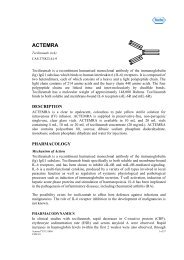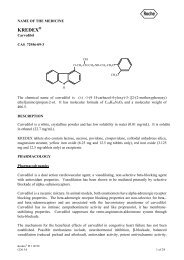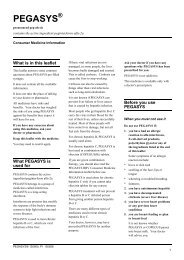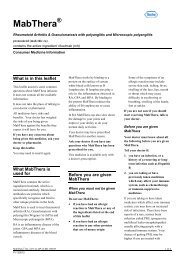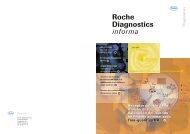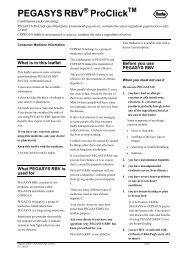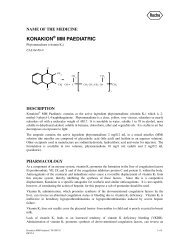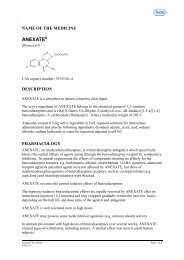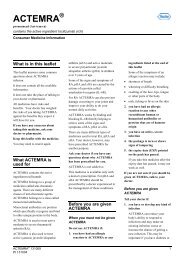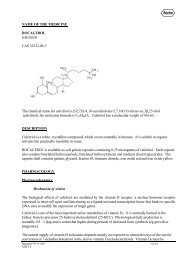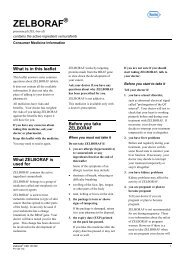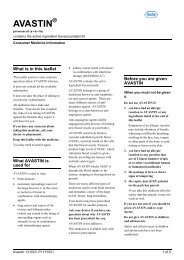Product Information PI - Roche Australia
Product Information PI - Roche Australia
Product Information PI - Roche Australia
Create successful ePaper yourself
Turn your PDF publications into a flip-book with our unique Google optimized e-Paper software.
Secondary efficacy parameters: Both doses of TAMIFLU significantly reduced the median<br />
total symptom score AUC (measure of extent and severity of illness) by up to 40% compared<br />
to placebo. The duration of virus shedding was also reduced in subjects treated with<br />
TAMIFLU.<br />
Temperature AUC was reduced in TAMIFLU-treated subjects compared with placebo. Fewer<br />
subjects reported fever following dosing with TAMIFLU, despite a lower consumption of<br />
symptom relief medication (paracetamol) by the TAMIFLU groups compared to the placebo<br />
group. This was in addition to a marked reduction in the time taken for subjects on<br />
TAMIFLU to return to an afebrile state during the treatment interval compared with placebo.<br />
The overall incidence of secondary illnesses (such as bronchitis, otitis media, sinusitis and<br />
pneumonia) requiring antibiotic medication was reduced by 50% in TAMIFLU-treated<br />
subjects when compared with placebo. Subjects treated with TAMIFLU rated their health,<br />
activity and quality of sleep to be better than patients on placebo during the dosing period.<br />
Moreover, treatment with TAMIFLU was associated with a reduction in time taken to return<br />
to normal (pre-influenza) health status and ability to perform daily activity.<br />
Treatment of Influenza in Adolescents, Adults and Elderly – Study M76001<br />
In a recent study which included adolescents, adults and elderly patients (13 – 80 years), time<br />
to alleviation of all symptoms was significantly reduced by up to 24.2 hours in patients treated<br />
with TAMIFLU. There was a significant reduction of the median total symptom score AUC<br />
in the treatment group compared to placebo. Consistent with other studies, temperature AUC,<br />
number of patients with fever and the time to afebrile state were reduced in TAMIFLU treated<br />
subjects compared with placebo. There was also a reduced need for patients receiving<br />
TAMIFLU to take symptom relief medication (paracetamol).<br />
Treatment of Influenza in High Risk Populations – Study WV15758/872<br />
In a separate study, patients aged > 13 years with influenza and co-existing chronic cardiac<br />
and/or respiratory disease received TAMIFLU 75 mg or placebo twice daily. No difference in<br />
the median time to alleviation of all symptoms was seen between patients taking TAMIFLU<br />
or placebo. However, the duration of febrile illness was reduced by approximately one day in<br />
the TAMIFLU treatment group. The number of patients shedding virus on days 2 and 4 was<br />
also markedly reduced in those treated with TAMIFLU. There was no difference in the safety<br />
profile of TAMIFLU in the at-risk populations compared to the general adult population.<br />
Prevention of Influenza in Adults and Adolescents<br />
The efficacy of TAMIFLU in preventing naturally occurring influenza illness has been<br />
demonstrated in three seasonal prophylaxis studies and a post-exposure prophylaxis study in<br />
households. The primary efficacy parameter for all these studies was the incidence of<br />
laboratory-confirmed clinical influenza. Laboratory-confirmed clinical influenza was defined<br />
as oral temperature ‡ 37.2 ºC /99.0 ºF plus at least one respiratory symptom (cough, sore<br />
throat, nasal congestion) and at least one constitutional symptom (aches and pain, fatigue,<br />
headache, chills/sweats), all recorded within 24 hours, plus either a positive virus isolation or<br />
a 4-fold increase in virus antibody titres from baseline.<br />
Tamiflu <strong>PI</strong> 6 mg/mL oral suspension and capsules 120119 8 of 28<br />
CDS 10.0



